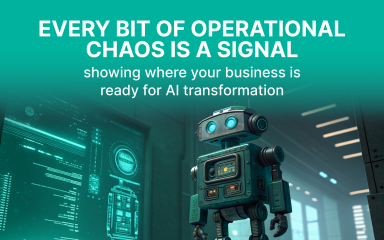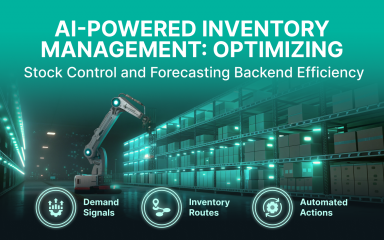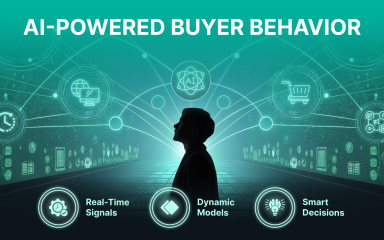Implementing AI is about scaling intelligence across your company, not about replacing people. The real goal is to augment human capabilities, allowing your teams to make AI-driven decision making that is faster, more accurate, and profoundly strategic. Business leaders are increasingly recognizing the importance of artificial intelligence (AI) for transforming operations and maintaining competitiveness.
AI enhances workplace productivity by automating time-consuming tasks and supporting employees in making more informed decisions. Artificial intelligence (AI) is fundamentally changing the way businesses operate, driving digital transformation across industries.
AI Implementation Matters Now: Closing the Intelligence Gap
For business transformation managers and C-level executives, AI is no longer a futuristic concept—it’s a critical factor for business survival. Companies that master how to implement AI in business are pulling ahead, while laggards risk being buried under mounting data complexity. The competitive gap is widening, fueled by the ability to process information at machine speed. AI has become a cornerstone for businesses across every industry, revolutionizing how organizations approach strategy, operations, and customer engagement. Leveraging AI and selecting the right AI tools is essential for maximizing AI capabilities and staying ahead in the market.
The evidence is clear: companies with AI-led processes achieve 2.5x higher revenue growth and 2.4x greater productivity than their peers. Yet, while 88% of executives plan to increase their AI budgets, many still struggle with an actionable deployment plan. This paradox highlights the urgent need for a structured AI business strategy. The global AI market is projected to grow from $621.19 billion in 2024 to $2.74 trillion by 2032, with North America leading the way with 41% of the market share.
How to implement AI in business means shifting from simply automating tasks to redesigning core workflows. You’ll learn the steps needed to build a mature AI implementation in business model, from initial pilot to full enterprise transformation. For example, Mattel uses AI to generate images and art for product development, showcasing how AI can transform creative workflows.
- Pull-Quote: “AI integration enhances customer service by anticipating customer needs, leading to an 18% boost in customer satisfaction, productivity, and market share for companies using intelligent technology.”
Step-by-Step AI Implementation Roadmap
Successfully adopting AI in business requires structure. A phased approach ensures alignment, manages risk, and builds internal trust with the technology. It moves beyond isolated projects to AI transformation in business. AI-powered automation delivers unmatched efficiency, accuracy, and adaptability to organizational processes. AI business process automation helps optimize business processes by reducing manual effort, increasing efficiency, and enabling real-time adjustments, while also providing actionable insights that drive continuous improvement.
Define Goals and Audit Readiness
Start by defining clear, measurable goals and KPIs. What specific business outcome will the AI system drive? For example: “Reduce customer churn by 10%,” or “Lower operational costs in logistics by 15%.” Success in AI integration for companies requires a strong foundation. You must audit two things:
- Data Quality: Do you have the clean, structured data needed to train the model? High-quality data should include access to historical data, customer data, and financial data. These diverse datasets are essential for training effective AI models, enabling accurate predictions, and supporting data-driven decisions across business functions.
- Technology Stack: Can your current systems (ERP, CRM) connect via APIs to the new AI tools for business?
The Pilot-to-Scale Framework
Start small. AI pilot projects are essential for learning and proving value without significant financial risk. The pilot should solve a defined, high-value problem in a contained environment. Once the pilot meets its KPI, you must rapidly scale the solution across other relevant departments or regions. This is how you achieve true AI business automation. For instance, AI can reduce forecasting errors by up to 50% and reduce lost sales due to inventory shortages by up to 65%. Additionally, AI-driven supply chain optimization and inventory management benefit from automation, leading to improved demand forecasting, streamlined logistics, and greater operational efficiency.
| Step | Objective | Tools/Resources | Expected Outcome |
| 1. Assess | Align AI goals with corporate strategy. | Executive sponsorship, AI adoption strategy workshop. | Clearly defined, high-impact use cases. |
| 2. Pilot | Prove technical feasibility and measure ROI. | Internal data scientists, cloud platforms (e.g., Azure AI), clean, labeled data. | Model accuracy validated; positive ROI demonstrated in a specific function. |
| 3. Integrate | Deploy the model into live business workflows by deploying AI models and utilizing AI automations to optimize business operations. | API development, specialized AI tools for companies, change management training. | Seamless AI in business processes; data flows between legacy systems and AI. |
| 4. Scale | Expand adoption across the enterprise. | Dedicated AI governance team, MLOps pipeline, centralized knowledge base. | Full AI implementation in business; systemic AI transformation in business. |
Ready to turn your AI vision into a reality? Get a structured plan for your organization: Boost Your Business with AI Consultancy.
Accessible AI for Small & Mid-Size Businesses
The myth that AI is only for large enterprises is outdated. Smaller companies can achieve significant wins quickly by focusing on readily available, cloud-based solutions. This democratizes the benefits of implementing AI in business. AI can help small businesses do more with less, enabling them to compete effectively with larger organizations.
The use of AI and modern AI technology empowers the small business owner to streamline operations, improve efficiency, and drive growth, making advanced tools accessible and practical for everyday business needs.
Quick Wins with Cloud AI and Automation
AI for small business often means utilizing third-party services for specific functions, bypassing the need to hire large internal data science teams. For instance:
- Customer Support: Implementing AI chatbots that handle 70-80% of routine customer inquiries, automating routine tasks and repetitive tasks such as answering FAQs and processing simple requests. This reduces the need for minimal manual intervention, allowing human agents to focus on complex issues.
- Marketing & Sales: Using AI for advanced lead scoring, prioritizing sales efforts based on the likelihood of conversion, or automating personalized email campaigns.
- Operations: Employing readily available tools for demand forecasting to reduce operational efficiencies and optimize ordering. AI can also automate data entry and invoice processing, streamlining these routine and repetitive tasks to achieve greater productivity AI for small businesses.
Using AI in business operations should target specific pain points where automation delivers clear, short-term ROI. For example, a small e-commerce company can use predictive analytics (embedded in platforms like Shopify or WooCommerce) to forecast which customers will churn, enabling proactive retention efforts. AI can analyze historical sales data, market trends, seasonality, weather patterns, and social media sentiment to generate demand forecasts.
Generative AI and Innovation Acceleration
The advent of generative AI in business has expanded the scope of AI-driven decision making beyond prediction and classification into creation and rapid ideation. This technology allows companies to accelerate product development and content creation dramatically. For instance, Coca-Cola improved its sales forecasts by over 20% using AI to analyze data.
Generative AI leverages machine learning, AI algorithms, and computer vision to deliver innovative AI solutions for complex business challenges, enhancing predictive analytics, operational efficiency, and intelligent automation.
Augmenting Creative and Knowledge Work
Generative AI models are now used for:
- Ideation and Prototyping: A product team can generate dozens of design concepts or marketing taglines in minutes, rapidly iterating on ideas that would have taken weeks to produce manually.
- Content Creation: Leveraging natural language processing, businesses can automate the creation of personalized web copy, draft customer responses, or summarize vast internal research documents for quicker executive review.
A leading retail brand used generative AI in business to analyze current fashion trends and customer feedback to quickly generate several hundred product descriptions and corresponding marketing visuals for a new line. This reduced their time-to-market for product content by 60%, accelerating sales and reducing dependence on outsourced copywriters.
To ensure accuracy and ethical deployment, AI automation in business that uses generative models must be supported by human-in-the-loop governance. Human expertise is essential for reviewing and refining all AI outputs, ensuring accuracy, quality, and brand alignment.
See how AI can enhance, not replace, your existing processes. Dive into our insights on AI in business process management.
AI agents are increasingly being used to autonomously support creative and knowledge work across various business functions, driving efficiency and innovation.
Responsible AI, Ethics, & Sustainable Scaling
True, scalable AI transformation in business requires more than technology—it demands governance. Without a focus on responsible AI, a company risks public backlash, regulatory fines, and flawed decision models. This is where AI adoption challenges meet corporate strategy. Businesses must prioritize data security and adhere to compliance regulations to avoid legal repercussions. Protecting sensitive data and ensuring responsible resource allocation are crucial when implementing AI software, as these factors help maintain trust, operational efficiency, and compliance.
The Foundation of AI Governance
Responsible AI is built on four pillars: fairness, transparency, accountability, and privacy. Executives must prioritize compliance with global frameworks like the EU AI Act and GDPR. Ignoring these rules is a costly mistake. For instance, 45% of respondents cite concerns about data accuracy or bias as a major AI adoption challenge. Overcoming this requires formal governance.
| Principle | Description | Example Practice | Business Impact |
| Fairness | Models must not perpetuate or amplify systemic bias. | Bias detection in AI tools; diverse training data sets. | Mitigates legal risk; preserves brand reputation. |
| Transparency | The logic behind key decisions is auditable and explainable. | Use of Explainable AI (XAI) dashboards for credit or hiring models. | Enables AI audit and compliance; builds user trust. |
| Accountability | Clear human responsibility for AI-driven outcomes. | Human-in-the-loop governance for high-stakes decisions. | Ensures prompt remediation and executive oversight. |
| Privacy | Data protection integrated throughout the AI lifecycle. | Data anonymization, adhering to privacy by design in AI standards. | Ensures regulatory AI compliance (e.g., GDPR). |
Change Management and Workforce Adaptation
The single biggest barrier to how to implement AI in business isn’t the technology, but the people. Effective AI implementation process management includes dedicated training to address employee fears and develop “AI literacy.” The goal is not elimination, but augmentation. By reducing the need for human intervention in routine processes, AI enables employees to focus on higher-value work and perform complex tasks. This change management approach is essential for achieving the full benefits of implementing AI in business.
Transitioning to an AI-first operating model requires structured leadership. Read about our approach to Compliance & Transformation.
The Bottom Line: From Pilot to Transformation
The successful deployment of AI is a phased journey. Early adopters start with quick-win AI pilot projects, but industry leaders turn this technology into systemic, enterprise-wide transformation. The ultimate success metric for an AI business strategy is how quickly and responsibly your company can integrate intelligence into its operational DNA. This creates a lasting competitive advantage.
AI-driven automation, including predictive maintenance, helps reduce operational costs and delivers significant cost savings for businesses by streamlining processes, minimizing downtime, and lowering manual intervention expenses.
| Business Aspect | Old DNA (Traditional) | New DNA (AI-powered) | Strategic Outcome |
| Decision Speed | Monthly/Quarterly reporting; delayed responses. | Real-time AI-driven decision making; proactive intervention. | Increased agility. |
| Risk Management | Reactive response to errors and failures. | Predictive analytics for supply chain and fraud; early warning systems. | Reduced exposure. |
| Customer Insight | Static customer segments and surveys. | Continuous learning from sentiment analysis and behavior; hyper-personalization. | Sustainable growth. |
| Operations | Manual task execution; siloed AI in operations. | AI automation in business for core functions; integrated AI business automation. | Higher productivity. |
FAQ Section: Implementing AI in Business (H2)
- What are the key steps to implement AI in business?: The key steps include defining clear business goals, auditing data and technology readiness, starting with an AI pilot project to prove value, integrating the model into existing AI for business processes, and scaling the solution under a robust responsible AI governance framework. AI enables businesses to optimize business functions such as HR, payroll, IT, and operations management, leading to improved efficiency and better decision-making.
- How can small businesses use AI effectively?: AI for small business is most effective when focused on quick, cost-effective wins using cloud-based AI tools for business. Examples include implementing AI chatbots for customer support, using simple generative AI in business for marketing content, or deploying predictive analytics for sales forecasting. AI can also help small businesses identify patterns in customer behavior and manage supply chains more effectively, enhancing transparency, automation, and regulatory compliance.
- What is responsible AI and why is it important?: Responsible AI is the ethical and legal framework ensuring AI systems are fair, transparent, and accountable. It is important because it mitigates risks like algorithmic bias and regulatory fines, preserving customer trust and ensuring the long-term sustainability of AI implementation in business.
- How to measure ROI of AI projects?: ROI is measured by comparing the system’s performance against predefined operational KPIs, such as percentage reduction in customer churn, the efficiency gain from AI automation in business, or the increase in sales accuracy driven by AI-driven decision making.
- How to scale AI after a pilot project?: To scale, you must build an MLOps pipeline for continuous monitoring, establish a cross-functional AI governance team, and secure executive commitment for broader investment and workforce training. The goal is to move from a single AI pilot project to systemic AI transformation in business.











